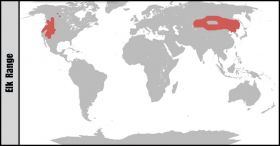The North American Elk
Cervus candensis
The second largest deer in the world: the Wapiti
The North American Elk is the second largest species of deer in the world, surpassed only by the moose. When Europeans came to the new world, the species Native Americans called the wapiti was an unfamiliar deer-like animal. It reminded them most of the moose, known in Sweden as the “elg” and in Germany as “Elch.” Thus, the name elk was given to the species Cervus canadensis.
Where do Elk live?
Elk are found throughout North America but mostly in the Rocky Mountains and west of them. If you include the Red deer, which has been recently combined with this species, the range extends to Asia.
What do Elk eat?
Elk forage on grasses, plants, leaves, and bark in the forest and forest-edge habitat. They are one of the few animals to do what is called “barking” where they tear off bits of the bark with their canines.
http://blip.tv/play/geMCgcupZQA
Elk Predators.
Other than humans there are several native North American mammals that prey upon elk. In particular, they are preyed upon by both grizzly and black bears and wolves. The wolf-elk relationship in Yellowstone is a classic predator-prey example. The predatory action of wolves in Yellowstone help keep elk in more forested areas. Without wolves they spend more time in riverbeds and decreased willow cover. This adversely effects other animals in the ecosystem.
Young calving elk are preyed upon by other predators, particularly bears, canines and cougars.
Antlers
Elk produce giant antlers weighing 40 pounds or more each. Typically they have five points. These antlers, unlike the horns of bovids, are bone that regrow each year. In the winter they drop their antlers and start growing new ones each spring.
http://blip.tv/play/geMCgcupFgA
Related Topics
The second largest deer in the world: the Wapiti
The North American Elk is the second largest species of deer in the world, surpassed only by the moose. When Europeans came to the new world, the species Native Americans called the wapiti was an unfamiliar deer-like animal. It reminded them most of the moose, known in Sweden as the “elg” and in Germany as “Elch.” Thus, the name elk was given to the species Cervus canadensis.
Where do Elk live?
Elk are found throughout North America but mostly in the Rocky Mountains and west of them. If you include the Red deer, which has been recently combined with this species, the range extends to Asia.
What do Elk eat?
Elk forage on grasses, plants, leaves, and bark in the forest and forest-edge habitat. They are one of the few animals to do what is called “barking” where they tear off bits of the bark with their canines.
http://blip.tv/play/geMCgcupZQA
Elk Predators.
Other than humans there are several native North American mammals that prey upon elk. In particular, they are preyed upon by both grizzly and black bears and wolves. The wolf-elk relationship in Yellowstone is a classic predator-prey example. The predatory action of wolves in Yellowstone help keep elk in more forested areas. Without wolves they spend more time in riverbeds and decreased willow cover. This adversely effects other animals in the ecosystem.
Young calving elk are preyed upon by other predators, particularly bears, canines and cougars.
Antlers
Elk produce giant antlers weighing 40 pounds or more each. Typically they have five points. These antlers, unlike the horns of bovids, are bone that regrow each year. In the winter they drop their antlers and start growing new ones each spring.
http://blip.tv/play/geMCgcupFgA

































































































